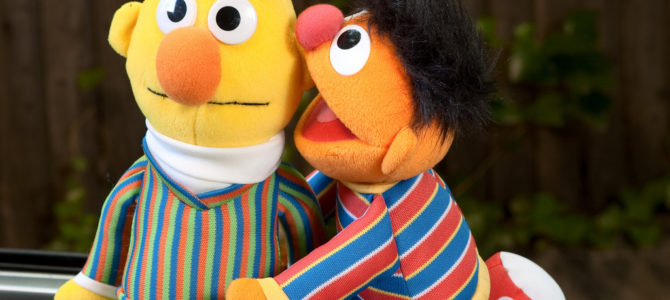
Former Sesame Street writer Mark Saltzman, in an interview with Queerty, said “without a huge agenda” he wrote Bert and Ernie as gay, based on his own life. He added, “I don’t think I’d know how else to write them, but as a loving couple.” The way in which media, including social media, ran with the story may be more interesting than Saltzman’s opinion.
After all, Sesame Workshop, the educational group that produces the show, issued a denial: “As we have always said, Bert and Ernie are best friends. They were created to teach preschoolers that people can be good friends with those who are very different from themselves. Even though they are identified as male characters and possess many human traits and characteristics (as most Sesame Street Muppets do), they remain puppets, and do not have a sexual orientation.”
The statement was virtually identical to the 2013 statement issued in response to a cover of The New Yorker suggesting the two longtime friends were in a relationship, as well as the 2011 statement issued after online petitions demanded the pair get married. This position seems fairly clear, if more polite than the formulation used in 2010 and as far back as 1994: “They are not gay, they are not straight, they are puppets. They don’t exist below the waist.”
Indeed, if Snopes is to be believed on this topic, speculation on the sexuality of Bert and Ernie dates as far back as 1980, even before Saltzman wrote for the show. What has changed is the underlying motivation for speculation that has been debunked repeatedly over decades.
Once upon a time, the idea that Bert and Ernie were not merely roommates but shacking up was borne of immature humor that would be condemned in many quarters today as rooted in latent—or patent—homophobia. It was a sort of teenage transgression like the idea that Batman and Robin were gay.
But just as jokes about the Dynamic Duo later gave rise to the parody of The Ambiguously Gay Duo, who were gay (or not), Bert and Ernie would be the subject of similar meta-comedy. In Avenue Q, a Sesame Street pastiche which became one of the longest running musicals in Broadway history, there is a pair of puppets named Rod and Nicky.
The latter’s suspicions of the former’s sexuality (in the song “If You Were Gay“) leads to conflict, even though Nicky is proven correct. These two ultimately reconcile, but their relationship is not sexual. The raging dumpster fire of social media, spurred on by traditional media, cannot even manage the “nuance” of Avenue Q.
Instead, the Workshop’s traditional statement met claims of a double-standard, citing the seemingly heterosexual if trans-species relationship between Kermit the Frog and Miss Piggy. For some reason, there are people who cannot distinguish between Sesame Street and The Muppet Show (and associated movies)—different products created with different purposes—simply because Kermit appears in both (a decision almost certainly more commercial than artistic). One can only imagine how blown these minds would be if they were ever shown the Muppets’ short-lived run on the first season of “Saturday Night Live.”
Indeed, Frank Oz, the Muppeteer who created Bert, received similar blowback after taking to Twitter on the subject:
It seems Mr. Mark Saltzman was asked if Bert & Ernie are gay. It's fine that he feels they are. They're not, of course. But why that question? Does it really matter? Why the need to define people as only gay? There's much more to a human being than just straightness or gayness.
— Frank Oz (@TheFrankOzJam) September 18, 2018
A long discussion ensued, complete with Muppet fans demanding he accept their interpretation of the characters he created and implying his simple response was motivated by disgust for LGBTQ people. These attacks seem baseless; Oz directed the gay-friendly “In and Out” back in 1997.
Nevertheless, this sort of backlash is increasingly common. Marvel Comics creator Stan Lee faced similar online attacks for opining that Peter Parker (the original Spider-Man) should remain a straight white man, while having no objection to creating new, more diverse characters.
So the imposition of homosexuality upon fictional characters, once the province of sexually insecure teenagers, has now become the bailiwick of the sort of identitarians who would have been the target of the first group in decades past.
The easy explanation for this strange evolution is the desire for representation in the popular culture. It is easy to see why movies like “Wonder Woman,” “Black Panther,” and “Crazy Rich Asians” become not merely successful, but phenomena: less-represented demographics understandably like seeing people who look like them get the validation of big-screen projects.
Of course, the movies still have to be good, as the unfortunate female “Ghostbusters” reboot demonstrated. And perhaps we will eventually get past the psychological demand for representation, but we are not there today.
Yet the representation rationale seems a bit strained in the context of gay and lesbian characters on television in the 21st century. In the course of a few decades, we have seen such representation go from the cutting edge to the merely titillating to relatively commonplace. If LGBTQ people are looking for role models, they are no longer in short supply.
What seems to be happening now is a form of reverse cultural appropriation, driven by technological progress. The information age has brought us a fractured cultural landscape. The monocultural spaces that existed before the internet became ubiquitous are increasingly difficult to find.
As a result, preexisting intellectual properties with brand awareness transcending our personal interests have become far more valuable. It is a large part of why Hollywood circles around comic books, videogames, remakes, reboots, reimaginings and the like.
In this environment, despite a cultural emphasis on diversity and multiculturalism, it is perhaps not surprising that previously unrepresented groups would like to stake their claims to older, monocultural icons. But sometimes, a Muppet is just here to teach kids about the ABCs, not the LGBTQs.









